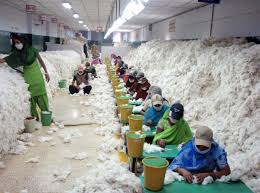GS 3 – Economy

Context
- Ministry of Textiles under the Azadi Ka Amrit Mahotsav initiative has extended the import duty exemption on cotton till 31st Dec 2025.
Cotton – Importance
- “White Gold”: Major commercial crop of India.
- Provides livelihood to 6 million farmers and supports the textile–apparel value chain employing 45+ million people.
- India = largest producer of cotton globally (~23% of world output).
Geographical Distribution
- Grown mainly in black cotton soil (regur) of Deccan Plateau.
- Major states (≈95% area):
- Gujarat (largest producer)
- Maharashtra
- Telangana
- Andhra Pradesh
- Punjab, Haryana, Rajasthan (North-west irrigated belt)
- Karnataka, Madhya Pradesh, Tamil Nadu (smaller shares)
Climatic Requirements
- Kharif crop – sown in April–May, harvested Oct–Jan.
- Requires:
- Temperature: 21°C – 30°C
- Rainfall: 50–100 cm (but needs clear sunny days during maturity)
- Irrigation crucial in north-west India.
Production Trends
- India’s share: ~23% of global cotton production.
- Area under cotton: ~12–13 million hectares.
- Bt Cotton: Introduced 2002 → now >90% area under Bt variety.
- Productivity remains lower than global average despite being top producer.
Trade & Exports
- Cotton textiles = 33% of India’s textile exports (~USD 7–8 billion annually).
- Major export destinations: USA, EU, Bangladesh, Vietnam, China.
- India also exports raw cotton but high-value exports (yarn, fabric, garments) are strategically important.
Policy & Institutional Support
- Minimum Support Price (MSP):
- Cotton Corporation of India (CCI) procures at MSP.
- MSP fixed at least 50% above cost of production (per Swaminathan formula).
- Schemes:
- Technology Mission on Cotton (TMC): quality improvement.
- Cotton Technology Mission Phase II: Ginning & pressing modernisation.
- PM MITRA Parks (2021): world-class textile parks.
- Duty-free imports (till Dec 2025): stabilises raw material supply.
- Exports Promotion:
- Duty Drawback, RoDTEP schemes.
- Free Trade Agreements (FTAs) negotiations to expand markets.
Challenges
- Low productivity compared to global average.
- Heavy dependence on Bt cotton → pest resistance (pink bollworm).
- Water-intensive crop → unsustainable in arid zones.
- Price volatility due to global cotton markets.
- Farmer distress despite MSP procurement.
- Competition from synthetic fibres (polyester, nylon).
Way Forward
- Diversify cotton varieties beyond Bt (introduce desi & pest-resistant hybrids).
- Strengthen irrigation efficiency (micro-irrigation).
- Enhance value-addition (move up from raw cotton exports to finished textiles).
- Expand global market access via FTAs & branding “Indian Cotton”.
- Promote sustainable cotton farming (organic cotton, climate-smart practices).




